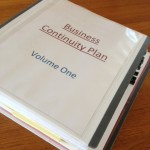Who’s in charge?
The person put in charge of coming up with a business Disaster Recovery or Continuity Plan is often not an expert in the field. In fact, most often in a small business the job is simply “assigned” to someone in the company – someone in IT, or human relations, or facilities management. But “Business Continuation” means a whole lot more than simply saving data, or meeting OSHA requirements. It means keeping the whole organization functioning so you will all be employed six months or a year from now!
Unfortunately, statistics on going out of business as the result of a disaster are not reliable – but it appears that even in the best of cases, your business’ chance of survival after a disaster without a plan are only about 60%. (“Business Continuity Statistics: Where Myth Meets Facts” documents often-quoted reports.)
Typical first step: Hire an expert — but with what result?

Comprehensive Business Continuity Plan — How useful?
The logical first step for the newly-assigned person is to hire a consultant, who IS a specialist. That individual or group submits its proposal, wins the contract, and then gets down to the research necessary to draft “The Plan.” Some weeks or even months later, “The Plan” is submitted. It may be approved and accepted.
In our experience, this method handicaps the consultant, who faces a dual challenge. He or she doesn’t know all the subleties of your business operations. And he or she may be forced to bid on putting a plan together that covers a number of bases without having access to all the factors that will impact the veracity of the plan. As a result, the needs analysis task is underestimated and the final plan misses some of the subtle but important factors that make the plan meaningful and credible.
If you go the route of seeking bids from consultants, you can help avoid this pitfall by doing some of the homework in advance. That way when (and if) you bring an expert planner into the organization they start with enough facts to bid realistically on pulling the plan together and are more likely to produce a real working plan that will save both lives and property.
Nevertheless, the result of these challenges is that most outside-developed plans we have seen (and we have seen many of them) are:
√ Very thick and intimidating (to justify the fee?)
√ Complex (to cover all the bases or the rear of the consultant)
√ Filled with jargon and therefore unreadable by the very people the plan is meant to protect!
Result: Plan goes onto the shelf.
Isn’t there a better process? Of course, and particularly for small businesses. Our recommendation is as follows.
Alternative method: Create the plan in-house.
Creating the Plan in-house requires more time and more dedication from the person in charge than simply hiring an outside expert to put it together for you. And it requires that employees at all levels be involved.
Over the years, we have found some good ways to encourage participation from within the organization — ideas which we’ll be sharing in the next Advisory, and also in a more complete form on our website.
If you’re in a hurry to learn more about the In-House Planning Method, here are links to the next two installments in this series:
- Installment Two – Development
- Installment Three – Validation
And if you know you need to get started right now, find out more about our free 6-page report: How to Build A Simple Business Continuation Plan.
